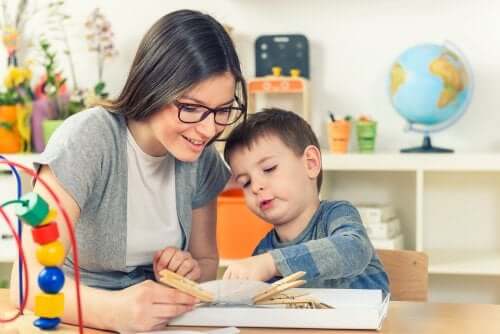What Are the Specific Needs for Educational Support?

School inclusion is a process of improvement and innovation, since it aims to minimize or eliminate barriers that limit students who require educational support and guidance due to specific educational needs.
For various reasons, children who have specific educational needs may start to feel different or misunderstood. This is something that we, as society and as parents, have to avoid.
Therefore, we should demand that schools be open-minded and give equal attention to each of their students so that they can remain present in the ordinary educational system. With this being said, diversity is an opportunity for enrichment.
“It’s not about having the right to be equal, but about having the same right to be different.”
–Anonymous–
What are the specific needs for educational support among students?
The concept of specific needs for educational support targets students who require special support and attention at school. This is because they meet certain criteria or have learning disabilities.

There are a wide range of students who fit into this group. For children to be considered a student with specific needs for educational support, they must belong to one of the following five categories:
-
Students that have the following disabilities or disorders:
- Serious developmental disorders
- Intellectual disability
- Communication disorders
- Motor disability
- Autism spectrum disorder
- Hearing disability
- Serious behavior disorders
- Visual disability
- Attention deficit disorder, with or without hyperactivity
- Rare and chronic diseases
2. Students with specific learning disabilities
This group includes children who suffer from alterations in the acquisition and development of basic cognitive processes used in writing, reading, arithmetic and speech. These children may suffer from:
- Dysgraphia
- Dyslexia
- Dyscalculia
- Speech difficulties
3. High intellectual abilities
This includes children who are above average in one or more intellectual capacities, otherwise known as talented and gifted children.
4. Late incorporation to the educational system
This includes migrant students who must adapt to their new school.
5. Personal conditions or school history
This includes children who aren’t at the level of their peers for reasons beyond their control, possibly due to the following reasons:
- Health issues
- Belonging to certain social groups or ethnic minorities
- Living in unfavorable sociocultural situations
- Dealing with in and out schooling
People involved in providing educational support
To respond to students with specific needs for educational support, cooperation must exist between:
- The school: tutors, counselors, faculty of therapeutic pedagogy and hearing and language, etc.
- The family
- Other specialized professionals: psychologists, physiotherapists, occupational therapists, etc.
The involvement of the aforementioned groups of people makes the process of offering adequate care and support to these children easier for the educational system. Thus, equal opportunities are guaranteed for all students to achieve maximum learning development.

In fact, without the existence of this collaboration, school faculty and staff can’t properly perform their duties. The reason why is because information from different sources is collected in order to carry out a good pedagogical intervention.
“Individually, we are a drop. Together, we are an ocean.”
–Ryunosuke Satoro–
The above quote means that we can achieve great things, such as educational inclusion, based on each and every one of our efforts. This is the essence of teamwork!
Benefits of diversity in the classroom
Clearly, inclusive education is beneficial for people with specific needs for educational support. However, it’s also beneficial for other students in the classroom.
With this school, students grow up in a diverse climate. Respect is promoted and they learn how to socialize and deal with other children with different abilities.
Therefore, an inclusive classroom must have a cooperative learning structure, different from the individualistic and competitive structure of a traditional school.
In conclusion, we must organize the classes in a way that encourages and transmits values of camaraderie, coexistence and acceptance.
“If we teach children to accept diversity as something normal, it will not be necessary to talk about inclusion, but about coexistence.”
–Daniel Comín–
School inclusion is a process of improvement and innovation, since it aims to minimize or eliminate barriers that limit students who require educational support and guidance due to specific educational needs.
For various reasons, children who have specific educational needs may start to feel different or misunderstood. This is something that we, as society and as parents, have to avoid.
Therefore, we should demand that schools be open-minded and give equal attention to each of their students so that they can remain present in the ordinary educational system. With this being said, diversity is an opportunity for enrichment.
“It’s not about having the right to be equal, but about having the same right to be different.”
–Anonymous–
What are the specific needs for educational support among students?
The concept of specific needs for educational support targets students who require special support and attention at school. This is because they meet certain criteria or have learning disabilities.

There are a wide range of students who fit into this group. For children to be considered a student with specific needs for educational support, they must belong to one of the following five categories:
-
Students that have the following disabilities or disorders:
- Serious developmental disorders
- Intellectual disability
- Communication disorders
- Motor disability
- Autism spectrum disorder
- Hearing disability
- Serious behavior disorders
- Visual disability
- Attention deficit disorder, with or without hyperactivity
- Rare and chronic diseases
2. Students with specific learning disabilities
This group includes children who suffer from alterations in the acquisition and development of basic cognitive processes used in writing, reading, arithmetic and speech. These children may suffer from:
- Dysgraphia
- Dyslexia
- Dyscalculia
- Speech difficulties
3. High intellectual abilities
This includes children who are above average in one or more intellectual capacities, otherwise known as talented and gifted children.
4. Late incorporation to the educational system
This includes migrant students who must adapt to their new school.
5. Personal conditions or school history
This includes children who aren’t at the level of their peers for reasons beyond their control, possibly due to the following reasons:
- Health issues
- Belonging to certain social groups or ethnic minorities
- Living in unfavorable sociocultural situations
- Dealing with in and out schooling
People involved in providing educational support
To respond to students with specific needs for educational support, cooperation must exist between:
- The school: tutors, counselors, faculty of therapeutic pedagogy and hearing and language, etc.
- The family
- Other specialized professionals: psychologists, physiotherapists, occupational therapists, etc.
The involvement of the aforementioned groups of people makes the process of offering adequate care and support to these children easier for the educational system. Thus, equal opportunities are guaranteed for all students to achieve maximum learning development.

In fact, without the existence of this collaboration, school faculty and staff can’t properly perform their duties. The reason why is because information from different sources is collected in order to carry out a good pedagogical intervention.
“Individually, we are a drop. Together, we are an ocean.”
–Ryunosuke Satoro–
The above quote means that we can achieve great things, such as educational inclusion, based on each and every one of our efforts. This is the essence of teamwork!
Benefits of diversity in the classroom
Clearly, inclusive education is beneficial for people with specific needs for educational support. However, it’s also beneficial for other students in the classroom.
With this school, students grow up in a diverse climate. Respect is promoted and they learn how to socialize and deal with other children with different abilities.
Therefore, an inclusive classroom must have a cooperative learning structure, different from the individualistic and competitive structure of a traditional school.
In conclusion, we must organize the classes in a way that encourages and transmits values of camaraderie, coexistence and acceptance.
“If we teach children to accept diversity as something normal, it will not be necessary to talk about inclusion, but about coexistence.”
–Daniel Comín–
All cited sources were thoroughly reviewed by our team to ensure their quality, reliability, currency, and validity. The bibliography of this article was considered reliable and of academic or scientific accuracy.
- Booth, T. y Ainscow, M. (2015). Guía para la educación inclusiva: desarrollando el aprendizaje y la participación en los centros escolares. Madrid: OEI.
- Calle, R. C. (2010). La atención educativa integral a los alumnos con necesidades específicas de apoyo educativo: actitudes, valores y normas. Hekademos: revista educativa digital, (7), 23-42.
- Echeita, G. (2006). Educación para la inclusión o educación sin exclusiones. Madrid: Narcea Ediciones.
- Fernández, A. (2003). Educación inclusiva: Enseñar y aprender entre la diversidad. Revista digital UMBRAL, 13, 1-10. http://www.inclusioneducativa.org/content/documents/Generalidades.pdf
- López, S. I. M., & Valenzuela, B. G. E. (2015). Niños y adolescentes con necesidades educativas especiales. Revista Médica Clínica Las Condes, 26(1), 42-51. https://www.sciencedirect.com/science/article/pii/S0716864015000085
- Hegarty, S. (1994). Educación de niños y jóvenes con discapacidades. Principios y prácticas. http://centrodocumentaciondown.com/uploads/documentos/5c8eb2ecc42c60fe85eec6390710c2b962ab1378.pdf
- Briceño, E. D. (2003). Creatividad como un recurso psicológico para niños con necesidades educativas especiales. Sapiens. Revista Universitaria de Investigación, 4(2), 1-17. https://www.redalyc.org/pdf/410/41040201.pdf
- Arnaiz Sanchez, P. (2007). La educacion inclusiva: dilemas y desafios. Educacion, Desarrollo y Diversidad.
- Buey, M. . L. D. (2010). Educacion Inclusiva. Revista Española de Orientación y Psicopedagogía. https://doi.org/10.5944/reop.vol.21.num.2.2010.11538
- Damm Muñoz, X. (2014). Representaciones y actitudes del profesorado frente a la integración de niños/as con necesidades educativas especiales al aula común. http://www.repositoriocdpd.net:8080/handle/123456789/78
- López, S. I. M., & Valenzuela, B. G. E. (2015). Niños y adolescentes con necesidades educativas especiales. Revista Médica Clínica Las Condes, 26(1), 42-51. https://www.sciencedirect.com/science/article/pii/S0716864015000085
This text is provided for informational purposes only and does not replace consultation with a professional. If in doubt, consult your specialist.








